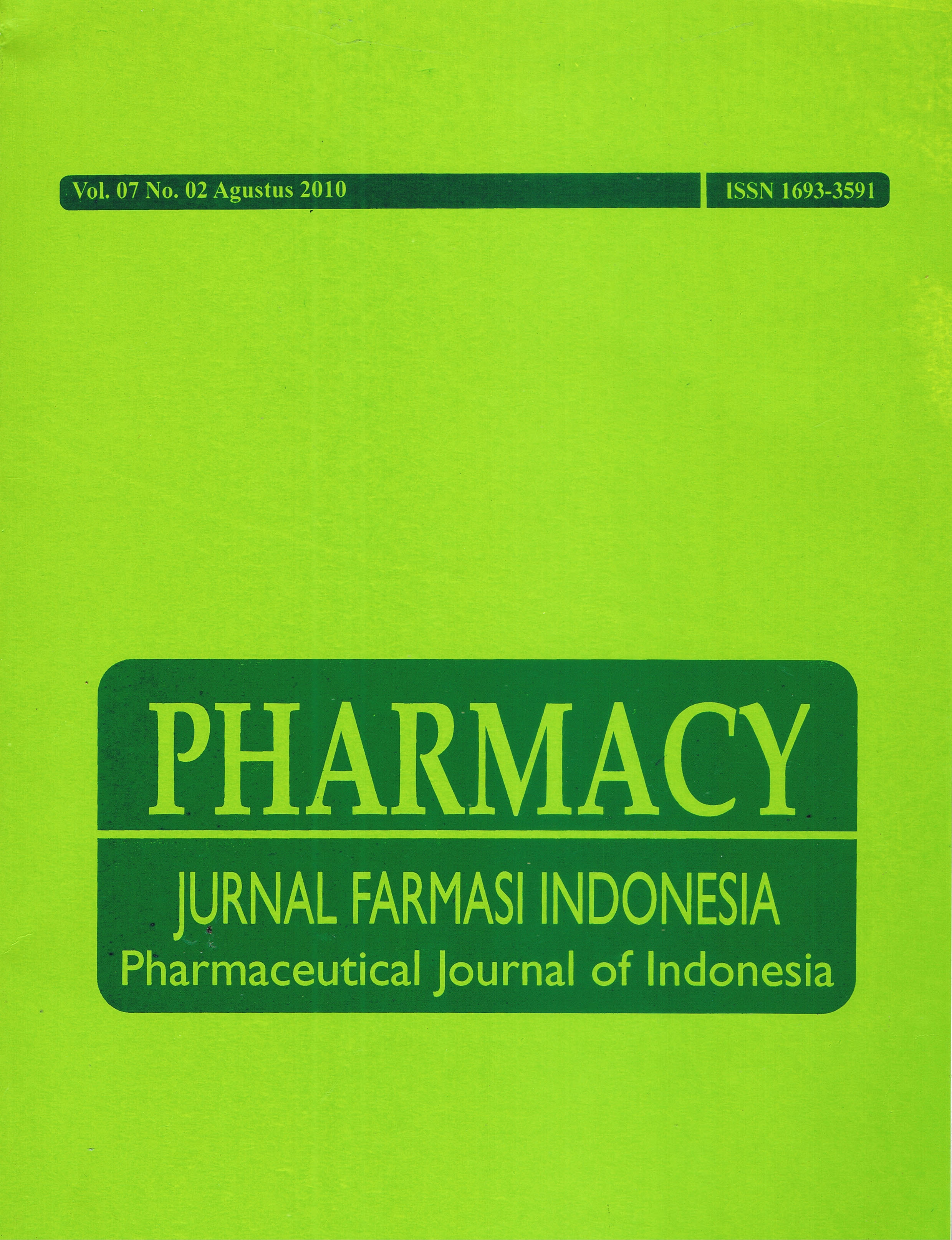EFEK PENAMBAHAN POLIVINIL PIROLIDON TERHADAP DISOLUSI TABLET PARASETAMOL
DOI:
https://doi.org/10.30595/pji.v7i1.563Abstract
ABSTRAK Parasetamol merupakan obat yang mempunyai sifat agak sukar larut dalam air sehingga di tambahkan bahan pembasah untuk menurunkan sudut kontak agar mudah terbasahi. Tujuan penelitian ini untuk mengetahui pengaruh penambahan polivinil pirolidon terhadap sifat fisik dan disolusi tablet parasetamol. Dalam penelitian ini dibuat tiga formula tablet parasetamol dengan konsentrasi polivinil pirolidon yang berbeda (0,10%, 0,15%, 0,20%) sebagai bahan pembasah. Tablet dibuat dengan metode granulasi basah dan kemudian tablet diuji sifat fisiknya meliputi kekerasan, kerapuhan, waktu hancur. Diuji disolusinya dengan medium dapar fosfat pH 5,8. Hasil penelitian ini menunjukan bahwa penambahan polivinil pirolidon sebagai bahan pembasah berpengaruh terhadap sifat fisik tablet parasetamol. Semakin besar konsentrasi bahan pembasah, maka tablet semakin rapuh, kekerasannya semakin kecil, waktu hancurnya semakin cepat, persentase kadar terlarut pada menit ke-30 semakin tinggi. Dan yang memenuhi syarat farmakope adalah yang konsentrasinya 0,15% dan 0,20%. Kata kunci : polivinil pirolidon, bahan pembasah, tablet parasetamol ABSTRACT Paracetamol is kind of drug which is rather difficult to dissolve so it should be added water for its dissolving decrease relating for. The aim of this research were to know the effect of polyvinylpyrolidone addition. In this research four formula of paracetamol tablet were made by varied concentration of polyvinylpyrolidone (0.10%, 0.15%, 0.20%) as wetting agent. Paracetamol tablet were formulated by wet granulation method, and the tablet were tested its physical characteristics including the hardness, friability, disintegration time. Disolution rate were assaid by phosphate buffer medium at pH 5,8. The result of this research showed that addition of polyvinylpyrolidoneas wetting agent influenced on paracetamol tablet physical characteristics. The more concentration of wetting agent, the more friability, the less of hardness, the faster of disintegration time and the increasing of C30. and at concentration 0.15% and 0.20% are according to pharmacopea. Keywords : Polyvinylpyrolidone, wetting agent, paracetamol tabletReferences
Aiache, J.M., Devissaguet,J., 1993. Farmasetika 2, (Terjemahan). Soeratri, Widji, Surabaya: Airlangga University Press. 172-197.
Abdou HM,. Dissolutions Bioavailability and Bioequivalence. Mark publishing Co. 1989.
Agoes, G. 2006. Pengembangan Sediaan farmasi. Bandung : ITB. Hlm 188, 192, 191, 190, 189, 180, 173.
Anief, M. 2002. Farmasetika.Yogyakarta: UGM Press. Hal 211
Ansel, H. 1989. Pengantar Bentuk Sediaan Farmasi. Ed ke 4. Penerjemah,, Farida, 1. Jakarta : UI Press. Terjemahan dari : Introduction to Pharmaceutical Dosage Forms. Hlm 96, 224, 247, 252, 255, 266, 269, 212, 271, 264, 263, 261, 244, 246.
Arikunto, S. 2005. Manajemen Penelitian. Jakarta: Rineka cipta. Hlm 47.
Banker, G.S. 1979.Modern Pharmaceutics.USA : Mack Publishing Company. Hlm 381, 382.
Chiou W.L., Riegelman S, Pharmaceutical Applications of Solid Dispersion System. S.of pharm.Sci 60(9). 1971: 1281-1302.
Depkes RI. 1979. Farmakope Indonesia. Ed ke 3.Jakarta: Departemen Kesehatan Republik Indonesia. Hlm 6, 7, 338, 59, 354, 37.
___________. 1995. Farmakope Indonesia. Ed ke 4.Jakarta: Departemen Kesehatan Republik Indonesia. Hlm 5, 515, 649, 650, 687, 404, 595.
Geneidi, A. SH., Ali, A.A., Salama, R.B., 1978. Solid Dispertions of Nitrofurantoin, Ethotoin and Cumarin with PEG 6000 and their Coprecipitates with Povidone 25.000, Journal of Pharmaceutical Sciences. Vol.67. No 1 Januari 1978. 114-115.
Lachman, L., Lieberman, HA., Kanig, J.L. 1994. Teori dan Praktek Farmasi Industri. Ed ke 3. Penerjemah: Siti Suyatmi. Jakarta: UI Press. Terjemahan dari: The Theory and Practice of Industrial Pharmacy. Hlm 482, 987, 659, 655, 654, 653, 651, 667;668, 658, 699, 656, 690, 706-706, 703, 702, 698, 647.
Martin A., Swarbick, J., Cammarata A. 1993. Farmasi Fisik Dasar-Dasar farmasi Fisik dalam Ilmu farmasetika. Ed ke 3. Penerjemah: Yoshita. Jakarta: UI Press. Terjemahan dari : Physical Pharmacy. Hlm 845-846, 966; 1135.
Mulya dan Suherman. 1995. Analisis Instrumental. Surabaya: Universitas Airlangga. Hal 33-34.
Simonelli, A.P., Metha, S.C., and Higuchi, W.I., 1969. Dissolution Rates of High energy Polyvinilpyrolidone (PVP) Sulfathiazole Coprecipitate, J Pharm. Sci. 538-549.
Sulaiman, T.N.S. 2007.Teknologi Formulasi Sediaan Tablet. Yogyakarta: Laboratorium Teknologi Farmasi UGM. Hlm 211, 149, 150, 209, 207, 200, 199, 203.
Sugiyono. 2006. Statistik Untuk Penelitian. Bandung : Alfabeta.
Sugiyono. 2009. Stastistik Untuk Penelitian. Bandung : Alfabeta.
Sutriyo, Rosmaladew, Febrian HF. 2005. Pengaruh Polivinil Pirolidon terhadap laju disolusi Furosemid dalam sistem dispersi padat. Majalah ilmu kefarmasian II: 30-42.
Tan, H.T, and Rahardja, K. 2002. Obat-Obat Penting. Jakarta: PT. Elex Media Compatindo Kelompok Gramedia. Hlm 318.
Voigt, R. 1995. Pelajaran Teknologi Farmasi. Ed ke 5. Penerjemah: Noerono. Yogyakarta: UGM Press. Terjemahan dari: Lehrguch Der Pharmazeutischen Technologi. Hlm. 2004, 223, 211,204, 205, 225, 171, 259, 202, 210,
Wade A, Weller J. 1994. Handbook Of Pharmazeutical Excipients. Second Edition.London: American Pharmaceutical Association Society of Breat Writain. Hlm 84.
Rowe, P.C., Sheskey., S.C. Owen., 2003, Handbook Of Pharmaceutical Excipients, Fifth Edition., American pharmacist Association and pharmaceutical Press, Washington D.C. and London. Hlm. 508.
Downloads
Published
How to Cite
Issue
Section
License
Authors who publish with this journal agree to the following terms:
- Authors retain copyright and grant the journal right of first publication with the work simultaneously licensed under a Creative Commons Attribution 4.0 International License that allows others to share the work with an acknowledgement of the work's authorship and initial publication in this journal.
- Authors are able to enter into separate, additional contractual arrangements for the non-exclusive distribution of the journal's published version of the work (e.g., post it to an institutional repository or publish it in a book), with an acknowledgement of its initial publication in this journal.
- Authors are permitted and encouraged to post their work online (e.g., in institutional repositories or on their website) prior to and during the submission process, as it can lead to productive exchanges, as well as earlier and greater citation of published work (See The Effect of Open Access).






